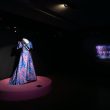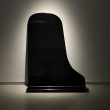It is a bit overwhelming to walk into Mountains of Wonder and Tangles of Truth: Kathy Hooper, a Retrospective at the Saint John Arts Centre. Often overshadowed by her husband, the late sculptor John Hooper, Kathy Hooper has had an equally, if not more, significant impact in the Canadian art world. Over the course of her six-decades-long career, Hooper has worked furiously, creating literal mountains of work from her home studio in Hampton, New Brunswick. Her work spans a vast range of media: she draws, paints, sculpts in both wood and ceramic, makes prints, writes—you name it. The result is a retrospective exhibition that feels somehow both chaotic and cohesive.
The breadth of Hooper’s career is immediately evident upon entering. Curator Amy Ash has selected works from the early 1960s to 2023 and has used the Saint John Arts Centre’s natural division of galleries to loosely group Hooper’s works by media. The foyer includes a few early works that informed her later pieces, and the larger gallery is dedicated to her major series of works, which were largely paintings. On the other side of the centre, the larger gallery is devoted to her drawings, which are the cornerstone of her artistic practice, and the smaller gallery houses works inspired by or for friends and family, where the medium varies widely.
Hooper was born in Kenya and raised in South Africa on a rural farm, far from any formal education opportunities. She and her siblings were home-schooled by her parents, who emphasized experiential learning and free thought. This exploratory approach to the world is evident in her work, particularly in her drawings, which are the catalyst of her creative process. Full of bright colours and strong black lines, her drawings explode onto the page, largely unplanned, and go wherever her hand takes her.
One of the newer pieces in Mountains of Wonder and Tangles of Truth, a 2023 drawing titled the complexity of it all, features a series of intricate line drawings that look almost like microscopic images of cells. Hooper writes, “I walked out of my studio one day and was overwhelmed by the complexity of it all.” This complexity is what she investigates through her drawings, be it the complexity of a landscape, a human being, an idea, or the world at large. This process is further illustrated through the inclusion in the exhibition of many of her rough drafts and sketchbooks. Flipping through these jumbles of drawing and poetry, sketches and snippets of prose, one can imagine Hooper sitting at her desk in her studio, creating on the fly.
Her curiosity also sometimes leads her to darker places. Hooper moved to Canada because the political situation in South Africa was becoming too limiting. An outspoken critic of apartheid (a system of institutionalized racial segregation in South Africa from 1948 to the 1990s) and an activist for racial and gender equity, Hooper needed to relocate her family to somewhere she could create art without fear for her safety, and this turmoil comes across in her work, notably in her Dark Series, of which the first is in the exhibition. In addition, grief plays a large role in her later works, notably the John Series, a collection of paintings inspired by her husband, who was a frequent collaborator and constant inspiration. These works were created between 2004 and 2006 and tackle the grief of both losing someone to Alzheimer’s while they’re still alive, and the grief of losing them completely when they die. “Living with grief creates a strange dislocation as overpowering thoughts and emotions shatter the days,” writes Hooper in a didactic panel.
She considers her entire life to be part of her creative practice, from working on the farm to raising her four children, to her partnership with her late husband. I’m a new mother, and on my first walk through the exhibition, I was moved to tears by the works depicting motherhood and femininity.
In Strong Woman 1, an ink drawing from 1970, a woman-like creature stands tall amid a sketched landscape, geometric sight-hounds in the foreground. The piece delves into feminism, power, expectations, and humanity. These are themes Hooper returns to in many other works, including Snarling Woman (Dog Series), a 1999 acrylic painting inspired by the stray dogs she came across when visiting Mexico. “Seeing a female dog protecting her pups made me reflect on being a mother, animal or human,” writes Hooper in a didactic panel.
The exhibition is greatly enhanced by the accompanying documentary, Mountains of Wonder, created by Matt Brown. The short film features interviews with some of Hooper’s closest friends and family, curator Ash, and of course the artist herself, to tell a beautiful story of a life lived wholly in service of art and creativity. In addition, it gives even more context to the various works that create the retrospective, including snippets of Hooper’s process, her emotions, and her worldview.
Mountains of Wonder and Tangles of Truth debuted at the Saint John Arts Centre on November 3, and ran until December 20. In 2024, it will travel to the Andrew and Laura McCain Gallery in Florenceville-Bristol, as well as the Beaverbrook Art Gallery in Fredericton.
















Leave a Reply